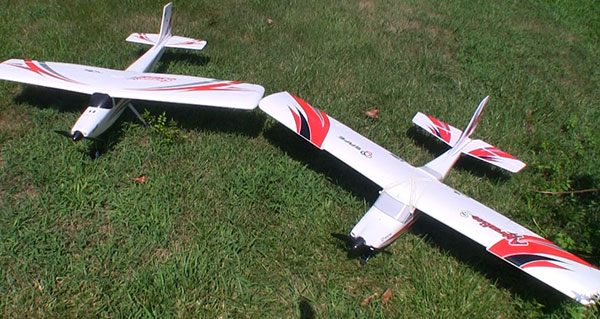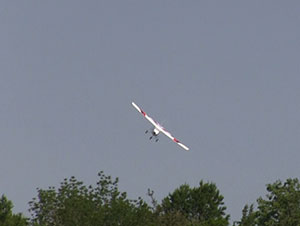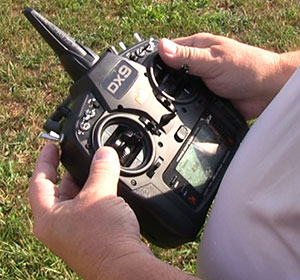



Text, photos and video by Tom Hintz
Apprentice® S 15e pilot – Mike Basmajian
Flight video by Clark Ponthier
Posted – 7-26-2016
While flying the Apprentice® S 15e (Horizon Hobby) and the Flyzone Sensei FS (Tower Hobbies) for our review, we noticed differences in how their stabilization systems performed. Both of these stabilization systems are advertised to “help” prevent a crash but more than a few sales persons at the local hobby shop level are leaving out the “help” part. Anyone with more than a passing understanding of RC flying knows there is no such thing as crash free. My concern is brand new pilots relying on this less than honest impression of the stabilization system capabilities and trying to teach themselves to fly without the help of a qualified instructor at a legitimate RC flying field.
The Apprentice® SAFE™ (Sensor Assisted Flight Envelope) and the Sensei WISE Flight Stabilization System have very similar modes. Both have a beginner’s mode that limits the amount of pitch and roll to around 15 degrees. The beginner’s mode prevents student pilots from over controlling the plane so they can get a basic feel for flying. You can hold full aileron or elevator on either plane in the beginner mode and the plane simply will not exceed the programmed angle of approximately 15 degrees.

The Apprentice® SAFE™ and Sensei WISE can actually land the plane in beginner’s mode if aligned with the runway with both needing only a small flair by the pilot when the plane gets down to the ground. Both planes have a very gentle decent in the beginner’s mode so some practice is needed to get the plane at a proper altitude for landing.
The Apprentice® S 15e can actually take off from the ground in beginner’s mode when surrounding terrain permits a slow climb out. I tried getting the Flyzone Sensei FS to take off on its own but it needs a good bit of elevator to get out of grass and then you have to hold some up elevator after liftoff or it noses down somewhat, certainly more than I am comfortable with immediately after takeoff. This is going to have to be drilled into the beginning pilot. While annoying, having to fly a plane out after takeoff is closer to real life than depending on a gyro to do it for you.
I think that the beginner’s mode in both the Apprentice® SAFE™ and Sensei WISE systems should be used sparingly to get a student pilot through their first few flights. As soon as they demonstrate any confidence in stick movement, especially with the plane coming towards them I would switch to the Intermediate mode to make flying more realistic so they learn more plane control without becoming dependent on the angle limiting of the beginner’s mode.
In both the Apprentice® SAFE™ and Sensei WISE systems the Intermediate mode lets the pilot get the plane to approximately a 90-degree angle to the ground but neither allows the plane to go inverted. We tried rolling the planes to inverted, adding rudder to force it over and using all elevator to guide the plane up and over to go inverted. None worked on either system. The Flyzone Sensei FS actually appeared to be hanging on the prop when I tried to loop it at full throttle in the intermediate mode. Both systems pushed the nose back down as soon as we released the aileron or elevator control.
I asked Mike to put the Apprentice® S 15e in the steepest bank the Intermediate mode would allow and then pull in all of the elevator to try and get the plane into a downward spiral that so many new pilots find themselves in. The Apprentice® SAFE™ system prevented it from going inverted and it did a good job of keeping the plane at roughly the same altitude while Mike held full aileron and elevator.
Later I tried the same thing with the Flyzone Sensei FS with dramatically different results. When I held full left aileron (I tried right also, no difference) and full up elevator the plane still refused to go inverted but allowed the Flyzone Sensei FS to begin a downward spiral. The spiral was much slower than usually happens without a gyro but it was still going down where the Apprentice® S 15e held its altitude and even climbed some.
Both planes seemed to land well in the Intermediate mode. Both land very slowly which takes the sharpness off of the controls even though there is more throw available to the new pilot. Both stabilization systems need just a touch of flair when the plane reaches the ground to avoid landing on the nose wheel first.

Usually a huge selling point at the hobby shop is the “bail out” or “rescue” (save) feature. Both the Apprentice® S 15e and Flyzone Sensei FS have what amounts to a panic function for when the pilot loses control. Supposedly pushing the Rescue switch brings the plane back to straight and level and all is fine.
The Apprentice® S 15e does in fact bring the plane to straight and level regardless of the position it was in when the rescue function was engaged. The Flyzone Sensei FS however did bring the pane back to upright and the wings reasonably level but the nose consistently dropped a good bit and required fairly urgent elevator application to prevent the Flyzone Sensei FS from flying into the ground or trees depending on the initial altitude.
We also tested the rescue function on both planes by putting them in a hard dive and then engaging the rescue system. The Flyzone Sensei FS made a fairly abrupt return to level but again needed more elevator input to get it out of a somewhat nose down attitude. When Mike pushed the rescue button on the Apprentice® S 15e in a dive it jerked the nose up instantly which was surprising considering the foam wing. The Apprentice® S 15e did survive and once it jerked itself to level it did a good job holding that altitude where the Flyzone Sensei FS needed further elevator to get it to level flight.
There is another issue with both of the save systems that is not a design error. Both planes do return to reasonably straight and level flight after the rescue function is engaged. However, they have absolutely no idea where the pilot is. The folks in the hobby shop seem to forget this point as well when they tell the customers that all they have to do is hit the save switch and all is well. I have been in the woods looking for three of these planes (two Apprentice® S 15e, one Flyzone Sensei FS) after the pilots hit the rescue switch after losing control. The problem in all three instances was that the planes were headed for the woods and the inexperienced (and now shaken beginner pilot) didn’t realize in time that they needed to get the plane turned around. All three continued on their post-rescue course until they encountered the woods. This is just one more situation where an experienced instructor could in most cases save the plane for the student and explain how the save was made.
Because these are relatively small aircraft hand launching might be the best idea on some grass runways, at least initially. These planes will fly off of most prepared grass runways once the pilot gains a little experience. It is important to remember that flying even a stabilized trainer out of a hand launch can be disastrous and even dangerous if they have not been trimmed out by an experienced pilot.
Both the Apprentice® S 15e VS. Sensei FS Stabilization Systems helped make flying out of a hand launch considerably easier and within the expected skills of a beginning pilot with a few lessons under their belt. The Apprentice® S 15e flew out of the hand launch essentially on its own where the Flyzone Sensei FS needed some up elevator to be held to keep the nose slightly up and gaining altitude.
Both of these stabilization systems need a decent hand launch to give them the opportunity to work. Both planes like the launch to be upwards but not steeply. With the plane at full throttle a gentle toss at 10 to 20 degrees up gives the plane and pilot a cushion to establish a decent rate of climb under control.
Both the Apprentice® SAFE™ and Sensei WISE are good teaching aides but neither is magic. The people selling these planes need to be more honest about the possibilities of a crash, particularly if the student pilot is not working with a qualified instructor. These systems certainly can shorten the overall time needed to get a new pilot to solo but the instructor remains a valuable resource that can explain WHY we do things when flying a plane or why the plane itself does things. And of course, the instructor can save a plane that virtually any stability system thinks can actually fly through a woods.
Of the Apprentice® SAFE™ and Sensei WISE the Apprentice® S 15e wins hands down. Its stability system just works better especially when matched against the needs of a student pilot. The Flyzone Sensei FS version kept needing up elevator in situations student pilots are known to get into frequently. You certainly can learn to fly with a Flyzone Sensei FS. There is no doubt about that. The Apprentice® S 15e is just the better plane overall. With the cost of getting in the air with both of these systems being so close the Apprentice® S 15e just makes more sense.
Visit the product pages for the Apprentice® S 15e or Flyzone Sensei FS.
Have a comment on this review? –Email Me!